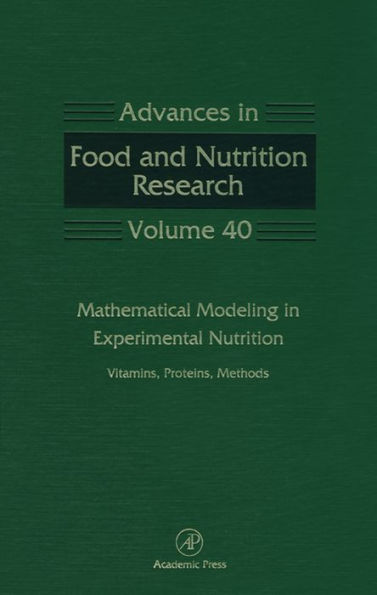Mathematical Modeling in Experimental Nutrition: Vitamins, Proteins, Methods
This book developed from a series of conferences to facilitate the application of mathematical modeling to experimental nutrition. As nutrition science moves from prevention of gross deficiencies to identifying requirements for optimum long term health, more sophisticated methods of nutritional assessment will be needed. Collection and evaluation of kinetic data may be one such method.
This books opens with chapters giving specific examples of the application of modeling techniques to vitamin A, carotenoids, folate, vitamin b-6, glycogen phosphorylase, transthyretin, amino acids, and energy metabolism. Obtaining kinetic data on internal processes is a major challenge; therefore, the text includes chapters on the use of microdialysis and ultrafiltration, use of membrane vesicles, and culture of mammary tissue.
Many of the authors use the Simulation, Analysis and Modeling program which allows compartmental models to be described without specifying the required differential equations. The final sections of the book, however, present some more mathematical descriptions of physiological processes, including bioperiodicity, metabolic control, and membrane transport; discussions of some computational aspects of modeling such as parameter distributions, linear integrators and identifiability; and alternative mathematical approaches such as neural networks and graph theory.
1100697664
This books opens with chapters giving specific examples of the application of modeling techniques to vitamin A, carotenoids, folate, vitamin b-6, glycogen phosphorylase, transthyretin, amino acids, and energy metabolism. Obtaining kinetic data on internal processes is a major challenge; therefore, the text includes chapters on the use of microdialysis and ultrafiltration, use of membrane vesicles, and culture of mammary tissue.
Many of the authors use the Simulation, Analysis and Modeling program which allows compartmental models to be described without specifying the required differential equations. The final sections of the book, however, present some more mathematical descriptions of physiological processes, including bioperiodicity, metabolic control, and membrane transport; discussions of some computational aspects of modeling such as parameter distributions, linear integrators and identifiability; and alternative mathematical approaches such as neural networks and graph theory.
- Specific, detailed examples of applications of modeling to vitamins, proteins, amino acids, and energy metabolism
- Novel methods for collecting kinetic data--microdialysis, ultrafiltration, membrane vesicles, and the culture of mammary tissue
- Mathematical treatment of complex metabolic processes including bioperiodicity, metabolic control, and membrane transport
- Computational approaches to distribution of kinetic parameters, evaluation of linear integrators, and identifiability
- Alternative mathematical approaches--neural networks and graph theory
- Detailed descriptions of the application of modeling to a variety of nutrients
Mathematical Modeling in Experimental Nutrition: Vitamins, Proteins, Methods
This book developed from a series of conferences to facilitate the application of mathematical modeling to experimental nutrition. As nutrition science moves from prevention of gross deficiencies to identifying requirements for optimum long term health, more sophisticated methods of nutritional assessment will be needed. Collection and evaluation of kinetic data may be one such method.
This books opens with chapters giving specific examples of the application of modeling techniques to vitamin A, carotenoids, folate, vitamin b-6, glycogen phosphorylase, transthyretin, amino acids, and energy metabolism. Obtaining kinetic data on internal processes is a major challenge; therefore, the text includes chapters on the use of microdialysis and ultrafiltration, use of membrane vesicles, and culture of mammary tissue.
Many of the authors use the Simulation, Analysis and Modeling program which allows compartmental models to be described without specifying the required differential equations. The final sections of the book, however, present some more mathematical descriptions of physiological processes, including bioperiodicity, metabolic control, and membrane transport; discussions of some computational aspects of modeling such as parameter distributions, linear integrators and identifiability; and alternative mathematical approaches such as neural networks and graph theory.
This books opens with chapters giving specific examples of the application of modeling techniques to vitamin A, carotenoids, folate, vitamin b-6, glycogen phosphorylase, transthyretin, amino acids, and energy metabolism. Obtaining kinetic data on internal processes is a major challenge; therefore, the text includes chapters on the use of microdialysis and ultrafiltration, use of membrane vesicles, and culture of mammary tissue.
Many of the authors use the Simulation, Analysis and Modeling program which allows compartmental models to be described without specifying the required differential equations. The final sections of the book, however, present some more mathematical descriptions of physiological processes, including bioperiodicity, metabolic control, and membrane transport; discussions of some computational aspects of modeling such as parameter distributions, linear integrators and identifiability; and alternative mathematical approaches such as neural networks and graph theory.
- Specific, detailed examples of applications of modeling to vitamins, proteins, amino acids, and energy metabolism
- Novel methods for collecting kinetic data--microdialysis, ultrafiltration, membrane vesicles, and the culture of mammary tissue
- Mathematical treatment of complex metabolic processes including bioperiodicity, metabolic control, and membrane transport
- Computational approaches to distribution of kinetic parameters, evaluation of linear integrators, and identifiability
- Alternative mathematical approaches--neural networks and graph theory
- Detailed descriptions of the application of modeling to a variety of nutrients
177.0
In Stock
5
1

Mathematical Modeling in Experimental Nutrition: Vitamins, Proteins, Methods
362
Mathematical Modeling in Experimental Nutrition: Vitamins, Proteins, Methods
362
177.0
In Stock

Product Details
| ISBN-13: | 9780080567853 |
|---|---|
| Publisher: | Elsevier Science |
| Publication date: | 12/02/1996 |
| Series: | Advances in Food and Nutrition Research , #40 |
| Sold by: | Barnes & Noble |
| Format: | eBook |
| Pages: | 362 |
| File size: | 6 MB |
About the Author
From the B&N Reads Blog
